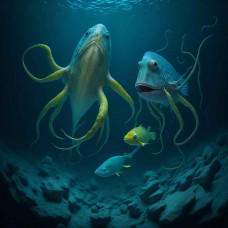The names of fish that spend most of their lives on or near the bottom of the sea (the latter are also called benthic fish) are: flatfish, halibut, skates, gobies, catfish, etc. However, most of these fish have pelagic eggs and larvae. Cod, haddock, saithe, hake, anglerfish, merlusa, nototenia and others spend a significant part of their lives near the bottom. During the spawning, fattening and wintering periods, benthic aggregations are formed by, for example, pollock, herring, capelin and sea bass. Demersal fish feed on benthos, or organisms that live in the lower layers of the water. Flounders, halibut, stingrays and some other fish have a body shape adapted to life on the bottom, have a pale colouration and can burrow into the bottom. Groundfish are caught with bottom fishing gear (snorkels, trawls, hook and line, fixed nets, etc.). Fish that sometimes ascend into the water column (cod, haddock, etc.) are also caught with pelagic gear.
Groundfish can be divided into two main types: strictly benthic fish, which can rest on the seabed, and bentopelagic fish, which can swim in the water column just above the seabed. Bentopelagic fish have neutral buoyancy, so they can swim at depth without much effort, while strictly benthic fish are denser and have negative buoyancy, so they can lie on the bottom without much effort. Most benthic fish have a benthopelagic lifestyle. In benthic fish, sand is usually pumped out of the mouth through the gill slit. Most benthic fishes have a flat belly to allow the body to rest more easily on the substrate. An exception may be the flounder, which is flattened at the sides but lies on its side. Many also have what is known as a "bottom" mouth, which means that the mouth points downwards; this is advantageous as their food is often found beneath them in the substrate.
Demersal fish are denser than water, so they can rest on the seabed. They can either lie low and wait to ambush predators, occasionally covering themselves with sand or otherwise camouflaging themselves, or they can actively move around the bottom in search of food. Bottom dwelling fish that can burrow include dragons, flounders and rays.
The bodies of bottom-dwelling fishes are adapted for constant contact with the seabed. Swim bladders are usually absent or reduced and the body is usually flattened in one way or another. According to Moyle and Chech (2004), they can be divided into five overlapping body types: bottom rovers, bottom shelters, flounders and rattlesnakes.
Bentopelagic fish live in the water just above the bottom and feed on benthos and zooplankton. Most bottom-dwelling fish have a bentopelagic lifestyle.
All deep-water bentopelagic bonefish have swim bladders. The dominant species, rattails and lump eels, have significant biomass. Other species include deep-sea cod (morays), deep-sea eels, halosaurids and notakans.
Bentopelagic fishes can be divided into two groups: flabby and robust. Flabby bentopelagic fishes are similar to bathypelagic fishes; they have reduced body mass and a low metabolic rate, and expend minimal energy when lying down and waiting to ambush their prey. An example of a flabby fish is the lumpy eel Acanthonus armatus, a predator with a huge head and a body that is 90 per cent water.
Deep-sea benthopelagic fishes are tough, muscular swimmers that actively scour the bottom in search of prey. They often live around places like seamounts where there are strong currents.
Commercial examples are orange roughy and Patagonian toothfish.
Benthic fish
Tags: Benthic fish



